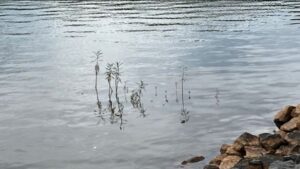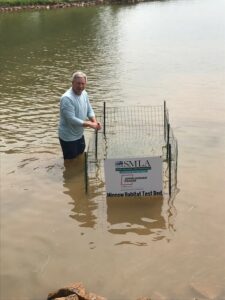19 Sep September 2023
SMLA’s “Bell Ringer” Water Willow Test Bed Suggests Triploid Sterile Grass Carp May Be Gone
Are Invasive Weeds Ready for Return to Smith Mountain Lake?
 Ten years ago, 6,000 Triploid Sterile Grass Carp were released into Smith Mountain Lake to consume non-native, invasive hydrilla that had clogged many coves. While the carp were extremely efficient in dealing with the hydrilla, these fish didn’t discriminate between nuisance weeds and beneficial plants. The result? Elimination of practically all submerged aquatic vegetation (SAV) in the lake.
Ten years ago, 6,000 Triploid Sterile Grass Carp were released into Smith Mountain Lake to consume non-native, invasive hydrilla that had clogged many coves. While the carp were extremely efficient in dealing with the hydrilla, these fish didn’t discriminate between nuisance weeds and beneficial plants. The result? Elimination of practically all submerged aquatic vegetation (SAV) in the lake.
This non-native grass carp is used widely to control invasive vegetation. The fish are known to have voracious appetites in their younger years, and as they grow (reaching over 30 inches and more than 10 pounds) this feeding behavior declines. These fish are sterile; specifically selected so that they cannot reproduce, and their assumed lifespan is approximately 8-10 years.
Now, 10 years later, it’s time to figure out if any of these fish are still present in the lake, and if they are not, should we start to worry that invasive weeds will reappear?
Water willow is a native shoreline plant which sterile carp are known to readily eat. This plant is excellent minnow habitat and controls erosion of unprotected shorelines. The water willow that is found on SML is generally seen up in remote coves, where the water is quite shallow and protected from heavy wake action. You will see it growing from the water in depths up to 6 inches, as the carp had fed on anything deeper. Normal depth is between 2-3 feet.
In late summer of 2022 with concurrence of Appalachian Power Company (APCO), Smith Mountain Lake Association (SMLA) volunteers harvested and planted a test bed of water willow in the cove that bisects the 5th hole on the Mariners Landing Golf Course. The bed was planted at a depth of two feet. A wire cage was used to protect the water willow from any remaining grass carp. The test bed was expected to serve as a “bell ringer” or indication that the carp had, or had not, reached the end of their 10-year lifespan.
Fast forward one year to August of this year, SMLA volunteers removed the cage and waited to determine if the water willow would be consumed.
After two weeks, the water willow appeared healthy with no sign of any carp disturbance. The water willow will now have the opportunity to grow and expand in the cove’s shallow water providing shelter for small fish and further supporting the shoreline restoration being conducted by Mariners Landing at this location.
While this test is not necessarily scientific, the results begin to indicate that the triploid sterile grass carp have significantly declined in numbers and continue to reach the end of their lifespan.
Recent surveys indicated that various areas of the lake have been reported to be supporting native vegetation again. Consequently, the APCO Aquatic Vegetation Technical Committee and SMLA’s volunteer dive teams must now be vigilant to the prospect of emerging invasive vegetation, such as hydrilla, that had previously clogged many parts of the lake.
SMLA supports annual surveys for SAV, which are performed by volunteer divers, including those from Scruggs Volunteer Fire and Rescue Dive team. The dive surveys around the lake will be taking place during the late September and October timeframe. Divers are trained to identify invasive and native submerged plants by SMLA volunteers and results will be reported to our members, Tri-County Lakes Administrative Commission (TLAC) and APCO.
This is just another example of how your support for SMLA serves to protect the water of SML.
For more information about this project and SMLA, visit our website: SMLAssociation.org.
For information about Invasive Species, click the link below.




